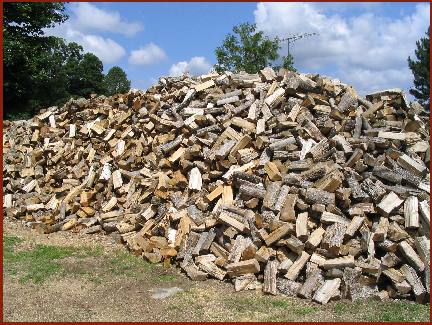Firewood Preparation
Burning wet wood is one of the two top barriers to pleasurable, efficient wood heating (the other is bad chimneys). Your wood heater can only operate with high efficiency and low emissions if your fuel wood has about the right moisture content. Properly seasoned firewood has moisture content of less than 20 per cent and is a pleasure to use.
The symptoms of poor performance related to wet firewood include:
- difficulty getting a fire going and keeping it burning well,
- smoky fires with little flame,
- dirty glass,
- rapid creosote buildup in the chimney,
- low heat output,
- the smell of smoke in the house,
- short burn times,
- excessive fuel consumption, and
- blue-gray smoke from the chimney.
In short, trying to burn wet wood is annoying and wasteful. Many of these problems can be eliminated by burning properly seasoned firewood.
 Wood piled like this could rot before it dries enough to burnSeasoning wood is not just a matter of cutting your wood and throwing it into a pile. Dry wood is the result of specific actions you take. A commercial wood supplier may claim to have wood “cut last summer”, or “two years old” and so on, but if the wood has been heaped in a field or just recently split, it will prevent your heater from performing to its potential. This is particularly true of modern EPA certified stoves, which perform extremely well when given the right fuel.
Wood piled like this could rot before it dries enough to burnSeasoning wood is not just a matter of cutting your wood and throwing it into a pile. Dry wood is the result of specific actions you take. A commercial wood supplier may claim to have wood “cut last summer”, or “two years old” and so on, but if the wood has been heaped in a field or just recently split, it will prevent your heater from performing to its potential. This is particularly true of modern EPA certified stoves, which perform extremely well when given the right fuel.
Properly seasoned wood has another important but less obvious benefit. If you cut and pile firewood right away, moulds will not have time to grow. Mould, if it allowed to develop, will escape into your home’s environment when you bring the wood inside. Mould is an undesirable in modern homes and comes from many sources in addition to firewood, but minimizing its growth and circulation improves comfort and reduces allergic reactions. Stacking and air drying firewood before mould has a chance to grow is a good plan.
To help you achieve a great fuel supply, here are five simple guidelines to follow:










